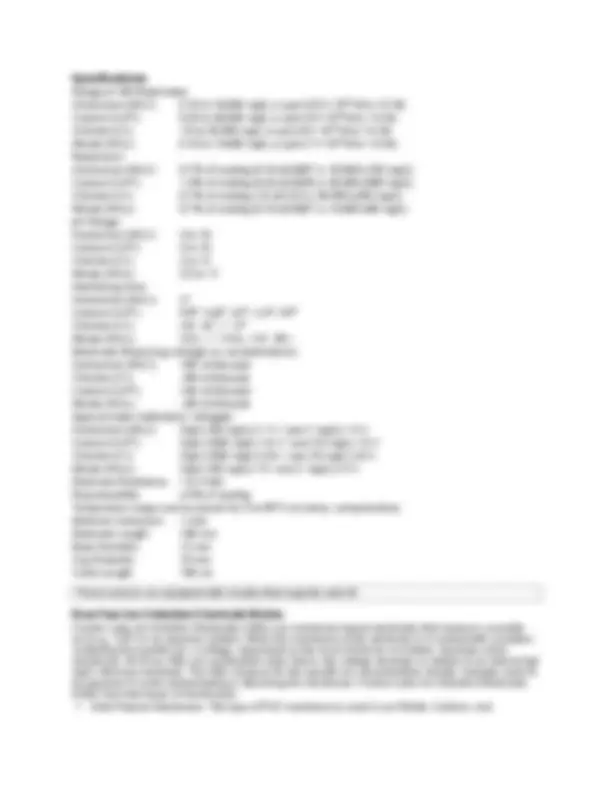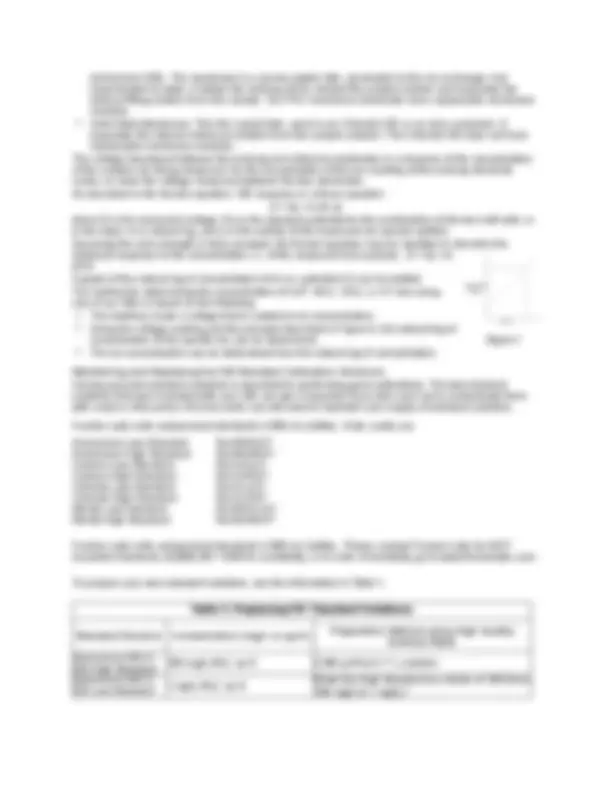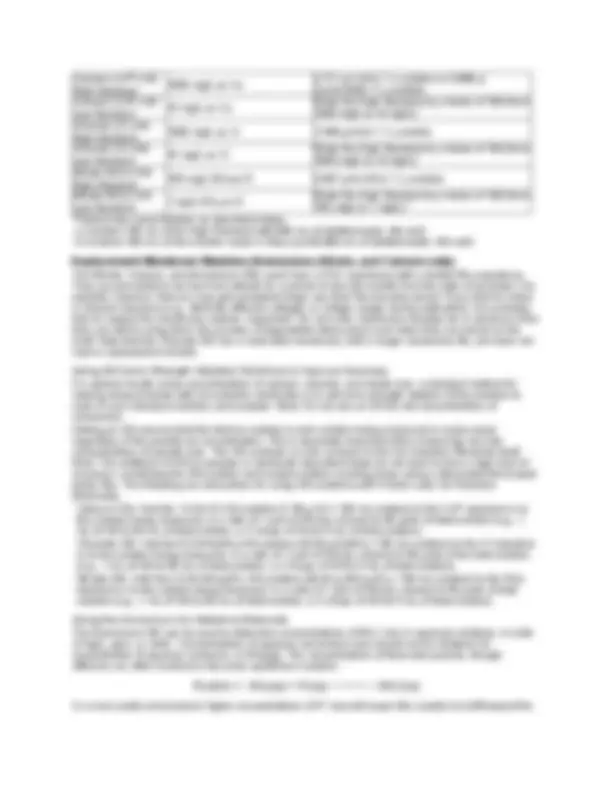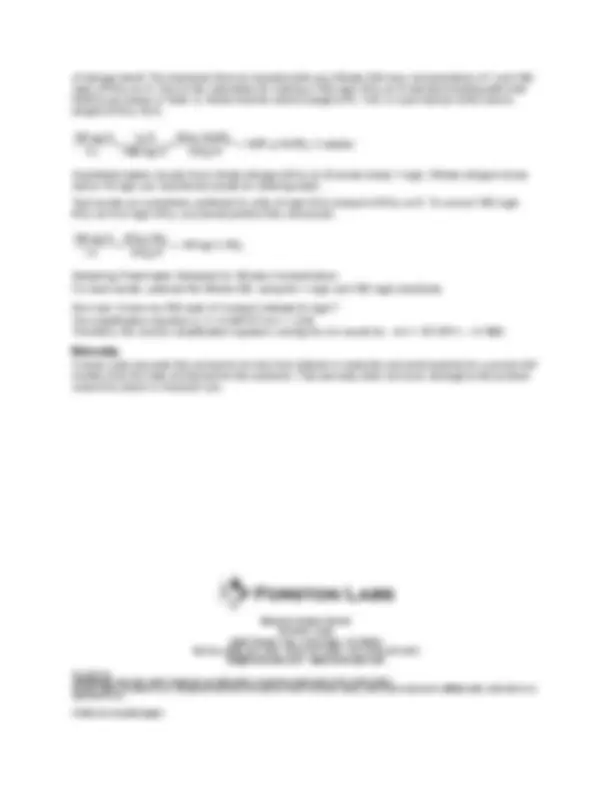







Study with the several resources on Docsity

Earn points by helping other students or get them with a premium plan


Prepare for your exams
Study with the several resources on Docsity

Earn points to download
Earn points by helping other students or get them with a premium plan
Community
Ask the community for help and clear up your study doubts
Discover the best universities in your country according to Docsity users
Free resources
Download our free guides on studying techniques, anxiety management strategies, and thesis advice from Docsity tutors
Information on the use of ion-selective electrodes (ISEs) for measuring concentrations of Ammonium (NH4+), Calcium (Ca2+), Chloride (Cl-), and Nitrate (NO3-) ions in aqueous solutions. details on the range of ISE electrodes, resolution, interfering ions, electrode slope, approximate calibration voltages, electrode resistance, and reproducibility. It also explains how to maintain and replace the ISE standard calibration solutions, and provides instructions for using ISA solutions to improve accuracy.
Typology: Slides
1 / 9

This page cannot be seen from the preview
Don't miss anything!






Ammonium Ion-Selective Electrode (Order Code NavNH4)
Calcium Ion-Selective Electrode (Order Code NavCA)
Chloride Ion-Selective Electrode (Order Code NavCL)
Nitrate Ion-Selective Electrode (Order Code NavNO3)
The Forston Labs Ion-Selective Electrodes can be used to measure the concentration of a specific ion in
aqueous samples. The species available include Nitrate (NO 3
), Chloride (Cl
), Calcium (Ca
2+ ), and
Ammonium (NH 4
).
Here is the general procedure to follow when using the ISE:
ISE) for approximately 30 minutes. Note: It is good laboratory practice to condition the electrode in a
standard solution with the same or slightly higher value than the anticipated value of the solution to be
tested. If the anticipated value is unknown or if such a standard is unavailable, use the High
Concentration Standard provided with the electrode. Important: Make sure the ISE is not resting on
the bottom of the container, and that the small white reference contacts are immersed. Make sure no
air bubbles are trapped below the ISE.
Soaking Bottle. Remove the cap from the bottle and fill it 3/4 full with High Standard. Slide the bottle’s
cap onto the ISE, insert it into the bottle, and tighten. Important: Do not leave the ISE soaking for
more than 24 hours. Long-term storage should be in the Long-Term ISE Storage Bottle.
with a BNC type connector. (see Electrode Amplifier Use below for Labnavigator setup for these type
of measurements.)
Labnavigator™ Setup for Use of the Electrode Amplifier (PN NavEamp)
The Electrode Amplifier allows the user to use electrodes using the BNC type connector with the
LabNavigator™. The Electrode Amplifier measurements are displayed in mV potential within the Meter
Screen.
To record the species being measured within the data, go to Table Tab and tap the Title Window. You can
then edit this for species name, run number, etc.
Note: If it is known if whether the species to be measured is monovalent (such as F
(such as Mg
2+ or Ca
2+ ), a shortcut for the analysis functions of the LabNavigator App is available:
the analog ports on the LabNavigator™.
ion measurements. Note: Although the display will show labels for Calcium or Nitrate, ALL the
measurements will be in the desired units and correct.
Calibrating the ISE
Standard. Enter the concentration value of the High Standard (For example; 100 for
100 mg/L or 1000 for 1000 mg/L).
with distilled water from a wash bottle, and gently blot dry with a paper towel or lab
wipe. Place the electrode into the Low Standard (included with your ISE). Important:
Make sure the ISE is not resting on the bottom of the container, and that the small
white reference contacts are immersed. Make sure no air bubbles are trapped below
the ISE.
10 mg/L). After 60 seconds, click enter and then done.
Collecting Data
bottom of the container, and that the small white reference contacts are immersed. Make sure no air
bubbles are trapped below the ISE. Note: Do not completely submerge the sensor. The handle is not
waterproof.
Proper care and storage of your ISE are important considerations for optimal longevity, especially with the
PVC membrane ISEs (Ammonium, Calcium, and Nitrate).
Bottle, which is included. The sponge in the bottom of the bottle should be kept moist with distilled
water. When you finish using the ISE, simply rinse it off with distilled water and blot it dry using a paper
towel or lab wipe. Loosen the lid of the bottle and insert the ISE. NOTE: The tip of the ISE should
NOT be touching the sponge. Check to be sure the white ceramic junctions are inside, rather than
outside the bottle or under the grommet. Tighten the lid. This storage system keeps the electrode in a
humid environment, which prevents the reference junctions from completely drying out.
included with the electrode. Fill the bottle 3/4 full with High Standard. Loosen the cap, insert the
electrode into the bottle, and tighten.
Ammonium ISEs. The membrane is a porous plastic disk, permeable to the ion exchanger, but
impermeable to water. It allows the sensing cell to contact the sample solution and separates the
internal filling solution from the sample. Our PVC membrane electrodes have replaceable membrane
modules.
separates the internal reference solution from the sample solution. The Chloride ISE does not have
replaceable membrane modules.
The voltage developed between the sensing and reference electrodes is a measure of the concentration
of the reactive ion being measured. As the concentration of the ion reacting at the sensing electrode
varies, so does the voltage measured between the two electrodes.
As described in the Nernst equation, ISE response is a linear equation:
E = Eo + m(ln a)
where E is the measured voltage, Eo is the standard potential for the combination of the two half cells, m
is the slope, ln is natural log, and a is the activity of the measured ion species plotted.
Assuming the ionic strength is fairly constant, the Nernst equation may be rewritten to describe the
electrode response to the concentration, C, of the measured ionic species: E = Eo + m
(lnC)
A graph of the natural log of concentration (lnC) vs. potential (V) can be plotted:
The method for determining the concentration of Ca
2+ , NH 4
, NO 3
one of our ISEs is based on the following:
concentration of the specific ion can be determined.
Maintaining and Replacing the ISE Standard Calibration Solutions
Having accurate standard solutions is essential for performing good calibrations. The two standard
solutions that were included with your ISE can last a long time if you take care not to contaminate them
with a wet or dirty probe. At some point, you will need to replenish your supply of standard solutions.
Forston Labs sells replacement standards in 500 mL bottles. Order codes are
Ammonium Low Standard: NavNH4LST
Ammonium High Standard: NavNH4HST
Calcium Low Standard: NavCALST
Calcium High Standard: NavCAHST
Chloride Low Standard: NavCLLST
Chloride High Standard: NavCLHST
Nitrate Low Standard: NavNO3-LST
Nitrate High Standard: NavNO3HST
Forston Labs sells replacement standards in 500 mL bottles. Please contact Forston Labs for NIST
traceable standards at (800) 301-1259 for availability, or to order immediately go to www.forstonlabs.com.
To prepare your own standard solutions, use the information in Table 1.
Standard Solution Concentration (mg/L or ppm)
Preparation Method using High Quality
Distilled Water
Ammonium (NH 4
)
ISE High Standard
100 mg/L NH 4
as N 0.382 g NH 4 Cl / 1 L solution
Ammonium (NH 4
)
ISE Low Standard
1 mg/L NH 4
as N
Dilute the High Standard by a factor of 100 (from
100 mg/L to 1 mg/L).*
Figure 3
Calcium (Ca
2+ ) ISE
High Standard
1000 mg/L as Ca
2.771 g CaCl 2 / 1 L solution or 3.669 g
CaCl 2 •2H 2 0 / 1 L solution
Calcium (Ca
2+ ) ISE
Low Standard
10 mg/L as Ca
Dilute the High Standard by a factor of 100 (from
1000 mg/L to 10 mg/L).*
Chloride (Cl
High Standard
1000 mg/L as Cl 1.648 g NaCl / 1 L solution
Chloride (Cl
Low Standard
10 mg/L as Cl
Dilute the High Standard by a factor of 100 (from
1000 mg/L to 10 mg/L).*
Nitrate (NO 3
High Standard
100 mg/L NO 3 as N 0.607 g Na NO 3 / 1 L solution
Nitrate (NO 3
Low Standard
1 mg/L NO 3 as N
Dilute the High Standard by a factor of 100 (from
100 mg/L to 1 mg/L).*
*Perform two serial dilutions as described below.
a.Combine 100 mL of the High Standard with 900 mL of distilled water. Mix well.
b.Combine 100 mL of the solution made in Step (a) with 900 mL of distilled water. Mix well.
The Nitrate, Calcium, and Ammonium ISEs each have a PVC membrane with a limited life expectancy.
They are warranted to be free from defects for a period of nine (9) months from the date of purchase; it is
possible, however, that you may get somewhat longer use than the warranty period. If you start to notice
a reduced response (e.g., distinctly different voltages or voltage ranges during calibration), it is probably
time to replace the membrane module. Important: Do not order membrane modules far in advance of the
time you will be using them; the process of degradation takes place even when they are stored on the
shelf. Note that the Chloride ISE has a solid-state membrane, with a longer membrane life, and does not
need a replacement module.
Using ISA (Ionic Strength Adjuster) Solutions to Improve Accuracy
For optimal results at low concentrations of calcium, chloride, and nitrate ions, a standard method for
making measurements with ion-selective electrodes is to add ionic strength adjuster (ISA) solutions to
each of your standard solutions and samples. Note: Do not use an ISA for low concentrations of
ammonium.
Adding an ISA ensures that the total ion activity in each solution being measured is nearly equal,
regardless of the specific ion concentration. This is especially important when measuring very low
concentrations of specific ions. The ISA contains no ions common to the Ion-Selective Electrode itself.
Note: The additions of ISA to samples or standards described below do not need to have a high level of
accuracy—combining the ISA solution and sample solution counting drops using a disposable Beral pipet
works fine. The following are instructions for using ISA solutions with Forston Labs Ion-Selective
Electrodes.
Calcium ISA: Add the 1.0 M KCl ISA solution (7.46 g KCl / 100 mL solution) to the Ca
2+ standard or to
the solution being measured, in a ratio of 1 part of ISA (by volume) to 50 parts of total solution (e.g., 1
mL of ISA to 50 mL of total solution, or 2 drops of ISA to 5 mL of total solution).
Chloride ISA: Add the 5.0 M NaNO 3 ISA solution (42.50 g NaNO 3 / 100 mL solution) to the Cl
or to the solution being measured, in a ratio of 1 part of ISA (by volume) to 50 parts of the total solution
(e.g., 1 mL of ISA to 50 mL of total solution, or 2 drops of ISA to 5 mL of total solution).
Nitrate ISA: Add the 2.0 M (NH 4 ) 2 SO 4 ISA solution (26.42 g (NH 4 ) 2 SO 4 / 100 mL solution) to the NO 3
standard or to the solution being measured, in a ratio of 1 part of ISA (by volume) to 50 parts of total
solution (e.g., 1 mL of ISA to 50 mL of total solution, or 2 drops of ISA to 5 mL of total solution).
Using the Ammonium Ion-Selective Electrode
The Ammonium ISE can be used to determine concentrations of NH 4
ions in aqueous solutions, in units
of mg/L, ppm, or mol/L. Concentrations of aqueous ammonium ions should not be mistaken for
concentration of aqueous ammonia, or NH 3 (aq). The concentrations of these two species, though
different, are often involved in the same equilibrium reaction:
Reaction 1: NH 3 (aq) + H
(aq) ←⎯⎯→ NH 4
(aq)
In a more acidic environment, higher concentrations of H
ions will cause this reaction to shift toward the
It is important to remember that total hardness, taking into account both the Ca and Mg levels, will be
about 1.5 times higher than your calcium hardness value. Water hardness varies considerably in different
parts of the United States, from levels of less than 60 mg/L (total hardness as CaCO 3 ) in Washington,
Oregon, Louisiana, Mississippi, Tennessee, and New England, to levels exceeding 250 mg/L or higher in
Midwestern states (Ohio, Indiana, Illinois, Iowa, Nebraska, South Dakota, and Oklahoma). Water with a
hardness as CaCO 3 level greater than 120 mg/L is considered to be “hard,” while levels exceeding 180
mg/L are referred to as “very hard.”equivalence point occurs first, with the Mg
2+ equivalence point
following; therefore Ca
2+ can be determined as well as total hardness (as Ca
2+ and Mg
2+ ). A plot of ln
[Ca
2+ ] (natural log of calcium ion concentration) vs. volume is used to determine the equivalence point.
The second derivative can be used to calculate the point of maximum inflection at the equivalence point
of the titration.
Using the Chloride Ion-Selective Electrode
Chloride ions are found in freshwater samples as a result of water flowing over salt-containing minerals.
These salts might include either sodium chloride (NaCl) or potassium chloride (KCl). The chloride ion
concentration in seawater is approximately 19,400 mg/L—well below the upper limit of the Chloride ISE of
35,500 mg/L.
When the response of the Chloride ISE begins to slow, the membrane may need polishing. Cut a small
piece (about 1 inch square) from a polishing strip. Wet the end of the electrode and the dull side of the
polishing strip thoroughly with distilled water. Using only moderate pressure, polish the end of the
electrode by gently rubbing in a circular motion. This will remove the inactive layer of the membrane
which impedes measurement. Rinse thoroughly with distilled water and recalibrate in the usual manner.
Sampling Freshwater Samples for Chloride Concentration
For best results, calibrate the Chloride ISE using the 10 mg/L and 1000 mg/L standards.
Measuring Chloride Concentration of Saltwater or Brackish Water
When measuring chloride concentration in seawater or brackish water, calibrate the Chloride ISE using
the 1000 mg/L standard included with your Chloride ISE for one calibration point (or 1.806 parts per
thousand, or ppt). For the second calibration point, prepare a standard that is 20,000 mg/L Cl
32.96 g of solid NaCl to enough distilled water to prepare 1 L of solution:
If you are calibrating in ppt, call this solution 36.13 ppt.
Determining Salinity of Saltwater or Brackish Water
Salinity is the total of all salts dissolved in water, expressed either as mg/L (equal to parts per million,
ppm) or in parts per thousand (ppt). Seawater contains a fairly constant quantity of chloride ions. From
your measurement of chloride ion concentration (in the previous section), salinity can be calculated using
the following formula:
Salinity (mg/L or ppm) = 1.8066 × [Cl
Using this formula, the salinity of saltwater is calculated to be:
Salinity (mg/L or ppm) = 1.8066 × (19400 mg/L) = 35,000 mg/L
The level of salinity of seawater in parts per thousand, or ppt, would be:
Salinity (ppt) = 35000 / 1000 = 35 ppt
Using the Nitrate Ion-Selective Electrode
Nitrate ions, NO 3
primary source. Sometimes nitrates are present due to runoff from fertilized fields. Nitrates can also result
from the runoff from cattle feedlots and barnyards. In all of these cases, as plant and animal organisms
die, bacterial action breaks down the protein into ammonia, NH 3. Some ammonia is converted into
ammonium ions, NH 4
. Other bacterial action converts some of the ammonia and ammonium ions into
nitrite ions, NO 2
Units of Nitrate Concentration
Nitrate ion concentration is usually expressed in units of mg/L of NO 3
nitrogen.” This means that the concentration of nitrate is expressed as if the nitrate were only in the form
of nitrogen itself. The standards that are included with your Nitrate ISE have concentrations of 1 and 100
mg/L of NO 3
NaNO 3 (as shown in Table 1). Notice that the atomic weight of N, 14.0, is used instead of the atomic
weight of NO 3
Unpolluted waters usually have nitrate-nitrogen (NO 3
above 10 mg/L are considered unsafe for drinking water.
Test results are sometimes published in units of mg/L NO 3
Sampling Freshwater Samples for Nitrate Concentration
For best results, calibrate the Nitrate ISE, using the 1 mg/L and 100 mg/L standards.
How can I have my ISE read mV output instead of mg/L?
The amplification equation is: V = 0.00727*mV + 1.
Therefore, the reverse amplification equation, solving for mV, would be: mV = 137.55*V – 0.
Forston Labs warrants this product to be free from defects in materials and workmanship for a period of 9
months from the date of shipment to the customer. This warranty does not cover damage to the product
caused by abuse or improper use.
Measure.Analyze.Record
Forston Labs
4098 Trouble Trail • Fort Collins, CO 80524
Toll Free (800) 301-1259 • (970) 237-4395 • FAX (970) 237-
info@forstonlabs.com • www.forstonlabs.com
Rev 2/01/
LabNavigator, and other marks shown are our trademarks or registered trademarks in the United States.
All other marks not owned by us that appear herein are the property of their respective owners, who may or may not be affiliated with, connected to, or
sponsored by us.
Printed on recycled paper.